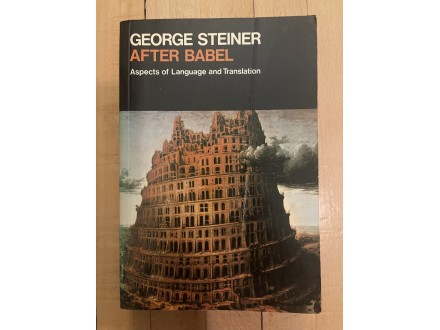George Steiner - After Babel
| Cena: |
| Želi ovaj predmet: | 3 |
| Stanje: | Polovan bez oštećenja |
| Garancija: | Ne |
| Isporuka: | Post Express |
| Plaćanje: | Tekući račun (pre slanja) |
| Grad: |
Beograd-Voždovac, Beograd-Voždovac |
ISBN: Ostalo
Godina izdanja: -
Jezik: Engleski
Autor: Strani
Jako lepo ocuvana. Vidi se na slici naslovna strana nekad bila prelomljena. Van toga malo pozutela usled vremena.
Dzordz Stajner Stejner
Oxford University Press
After Babel: Aspects of Language and Translation (1975; second edition 1992; third edition 1998) is a linguistics book by literary critic George Steiner, in which the author deals with the `Babel problem` of multiple languages.
After Babel is a comprehensive study of the subject of language and translation.[2] It is both a controversial and seminal work[3] that covers a great deal of new ground and has remained the most thorough book on this topic since its publication.[2] Director Peter Bush of the British Centre for Literary Translation at the University of East Anglia described the book as a `pioneering work which revealed all communication as a form of translation, and how central translation is to relations between cultures.`[4] Daniel Hahn at ContemporaryWriters.com wrote that `It is extraordinary in making a real contribution to translation studies, while remaining fairly self-contained and accessible to people who have never before given the matter a second thought.`[2]
After Babel was adapted for television in 1977 as The Tongues of Men, and was the inspiration behind the creation in 1983 of the English avant-rock group News from Babel. After Babel also inspired work by cultural psychiatrist Vincenzo Di Nicola on intercultural communication and cultural family therapy, adopting `beyond Babel` as a metaphor.[5]
In After Babel Steiner states `To understand is to decipher. To hear significance is to translate.` He challenges conventional theories of translation by maintaining that all human communication within and between languages is translation. He argues that deception was the reason for the development of different languages: it was humanity`s deep desire for privacy and territory that saw the creation of thousands of languages, each designed to maintain secrecy and cultural isolation.[1] Real translation between languages is impossible because the original meaning is always lost: the translated text is tainted by the translator`s own cultural beliefs, knowledge and attitudes.[6]
Steiner states that the reason for the lack of new developments in translation theory is that translation is a hermeneutical task, `not a science, but an exact art.` This is problematic for machine translation.[7] He then presents a new translation model that combines philosophical hermeneutics with existing translation studies to form a `systematic hermeneutic translation theory`. The new model comprises four `movements`: trust, aggression, incorporation, and restitution.[6] `Trust` and `restitution` honour the source text and its author`s intentions, while `aggression` and `incorporation` benefits the translator.[8]
Slanje posle uplate na tekući račun.
Izbegavam da saljem kao preporucenu tiskovinu - (1) zato sto knjiga mora sa se umota u papir i (2) moze da putuje dugo. Preporucujem CC posiljku: moze da se umota u karton i stize relativno brzno. CC posiljka je skuplja 20 dinara od tiskovine.
Živim na Trošarini (Voždovac); ako bi vam odgovaralo lično preuzimanje, najbolje da svratite u moj kraj.
Predmet: 73128129











